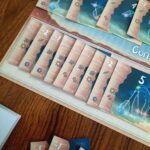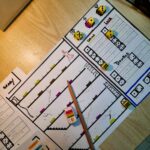Hanzō
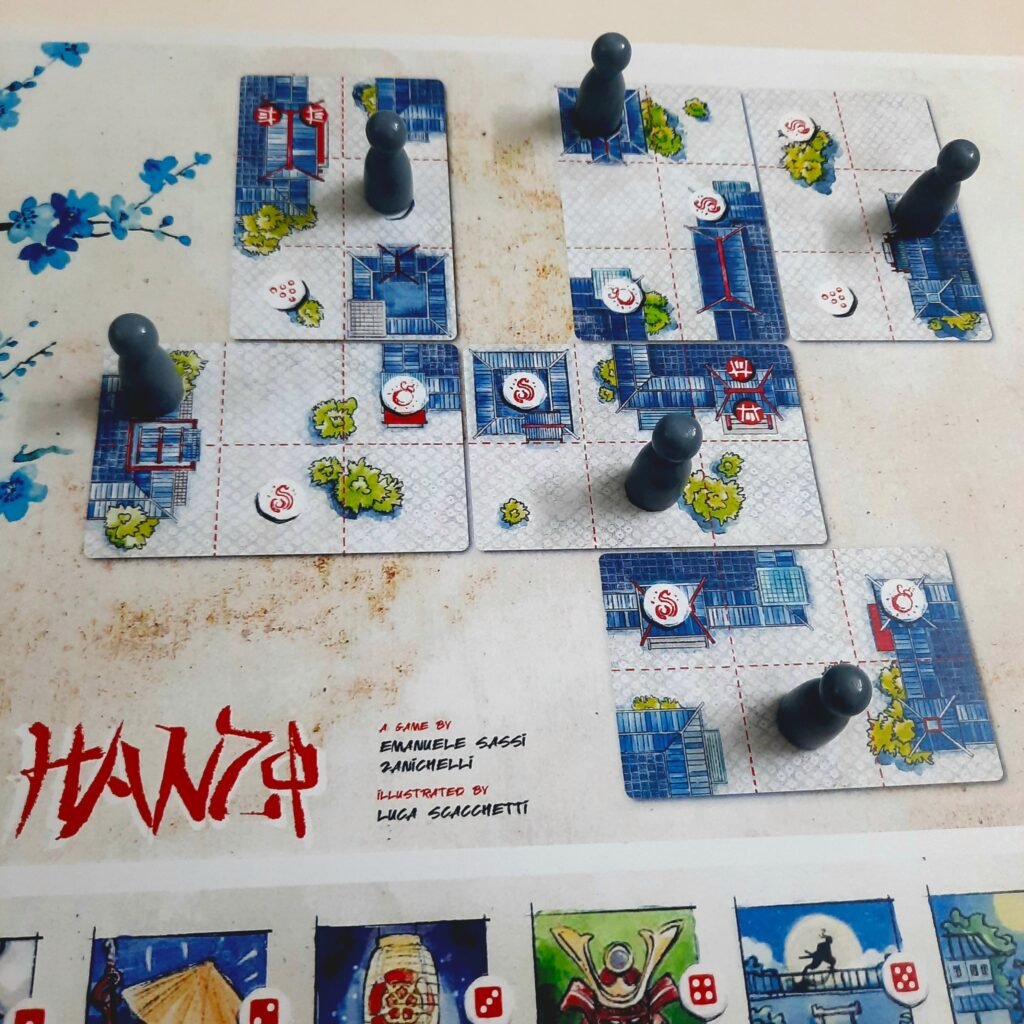
The Samurai came at night,
With orders cold and tight:
To steal your weapons in dread of fame,
Of a young ninja bound to earn a name.
Now, burning with purpose, you slip through moonlit shadows toward the Samurai village.
Ten sacred weapons await. One sacred house calls. When you reach it, you will no longer be Hanzō, the young ninja.
You will be HATTORI HANZŌ (服部半蔵).
After a super-hectic month of playtesting and sharing my thoughts on 9 PnP games for the Micro May campaign, I took a short hiatus until I stumbled upon the campaign for Hanzō.
Maybe it was the artwork, which felt effortlessly organic (almost like watercolor), or the intriguing dice placement mechanics that many in my game community were buzzing about, but I got genuinely curious. So, I reached out to Emanuele, the game’s designer, to give it a try. And I’m glad he sent it my way.
PS: I hope you liked the rhyme I wrote at the beginning of the article!
Questions that lingered in my ninja mind before trying the game:
+ The game’s campaign mentions, “Dice placement will never be the same” after playing Hanzō. Will that really be the case for me?
+ Hanzō can be played in both solo and 1v1. Which one will I enjoy more?
All you need
You don’t need much to play Hanzō, at least in terms of printing. You only need to print the player board and the map you want to play the game with.
Player board: There are a couple of boards in the game, one for solo play, the other for 1v1.
Maps: There are 3 maps to choose from. I’d recommend printing all 3 together. They don’t differ drastically, but at first glance, it seemed like each would bring some unique variation to the gameplay.
Once you are done printing, you can take either of the paths-
Path 1: Laminate the map and board. In that case, you can play using a whiteboard marker and 4 D6 dice
Path 2: Skip laminating the sheet and assemble 12 meeples/playing pieces, 8 small tokens, and 4 D6 dice.
I preferred playing the game with playing pieces and tokens instead of laminating it. The artwork for Hanzō is top-tier, and didn’t feel as tangible inside a layer of plastic.
By the way, avoid using D6 dice with numbers. Stick to the classic ones with pips. You’ll find out why soon enough.
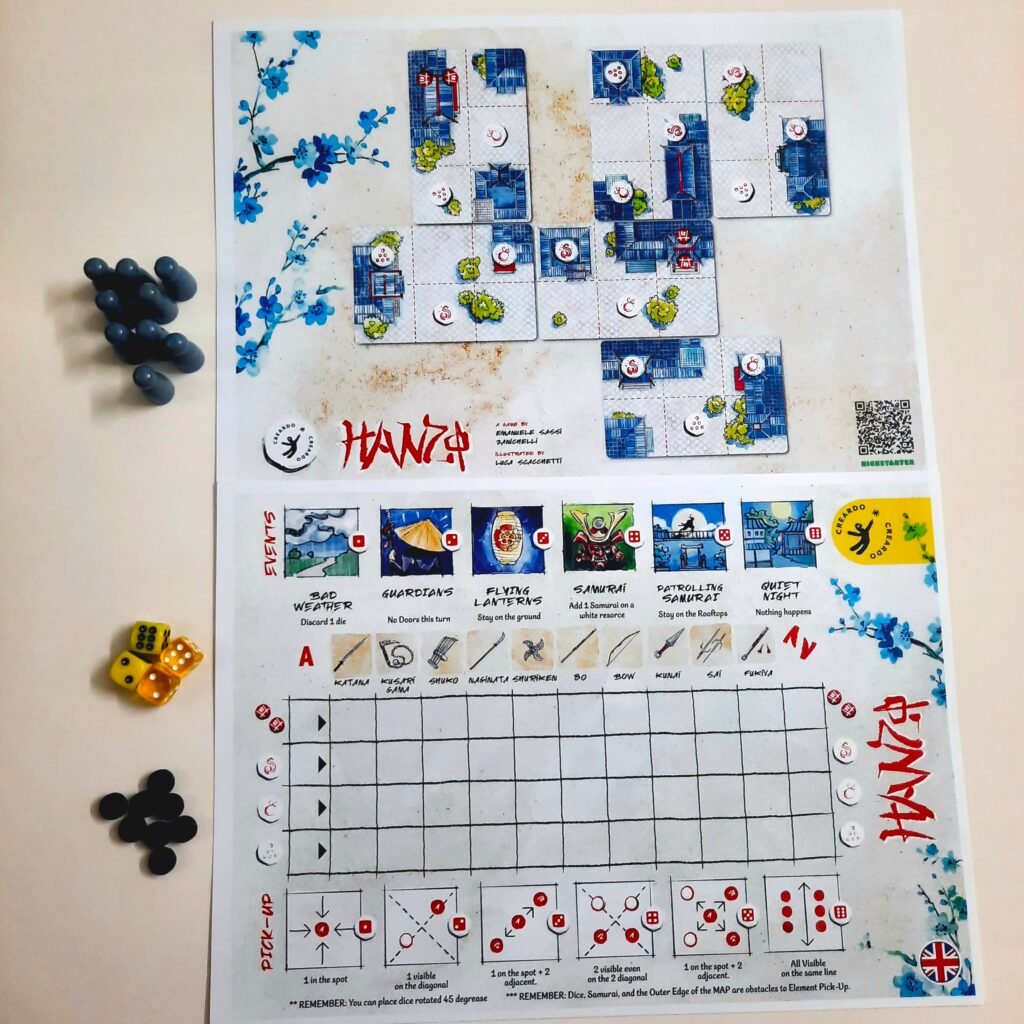
A bit about the game | E.g. playing solo
To play solo, start by choosing a map and placing 6 Samurai meeples on the white resource spots. These Samurai are obstacles to the resources they’re put on top of. Next, roll 4 dice and pick one value as your Event, then place a marker on the Event Grid.
Use the remaining dice to collect resources while sticking to the event conditions for the round; you can also rotate a die to get the resources you need. the game utilizes the alignment of the pips of the dice.
Mark your collected resources on the player board. When you have enough resources, you can obtain a Door resource to recover a weapon, which allows you to remove a Samurai from the map.
At the end of each turn, add 2 new Samurai to resource spots. You lose if you cannot gather resources, place dice, or add Samurai to the map.
And you win when all 4 tokens for the resources reach the Eleventh House!
My findings
After playing the game multiple times, both on solo and 1v1 mode, here are my findings:
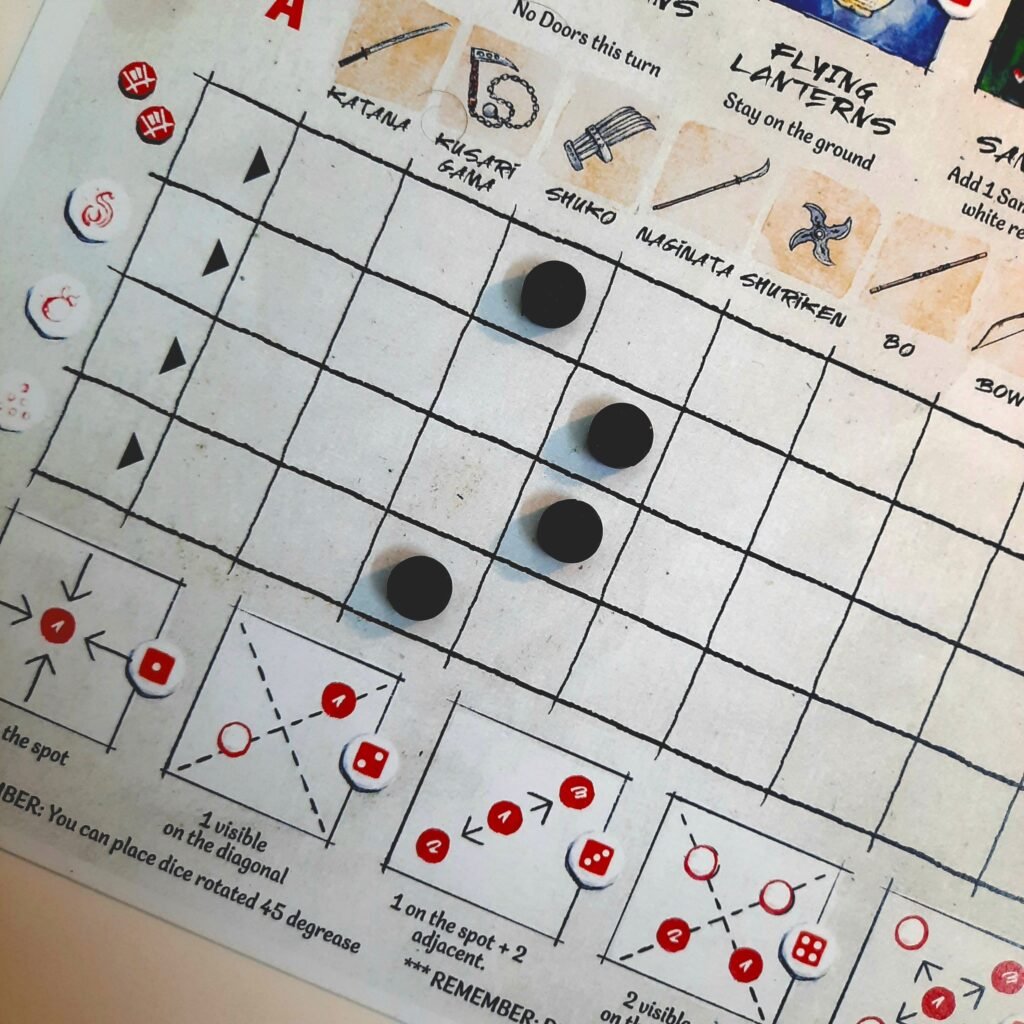
Dice placement mechanics deserve a nod
Brace yourself for a lecture on dice mechanics 101!
Over the years of playing and creating games, I’ve encountered a wide variety of dice mechanics. From classic dice allocation in games like Escape of the Dead or my own Escape the Living Library (ahem), to flipping or modifying dice values in games like Lantern, and even rotating dice to alter or select values in games like Hyperdrive Odyssey or Feral State: Revolt, I thought I’d seen everything there is to see when it comes to dice mechanics.
And then came Hanzō!
I never played a game that used both the pips on the dice and their alignment. On every round of the game, you have to collect resources by skillfully allocating dice on the map, and the number you roll and how you choose to rotate each die open up a wide range of ways to gain what you need. It’s something that I’ve never encountered before, and I’m fascinated by it. Kudos to Emanuele for coming up with something like this; it felt like a breath of fresh air.
I’d love to dive deeper into this mechanism, but that might turn this blog into a novella. So keep an eye out for a newsletter focused entirely on this topic. I’ll be dropping here, somewhere!
Eventful ‘Events’ creating a cycle
Hanzō is a game divided into phases. And on each phase, you have four rounds. Each phase starts with you (the ninja) having some breathing space, where you can choose from the 6 events at your disposal. It’s obvious you’d go for the events that can be easily negotiated. But keep in mind though, you cannot repeat an event in a phase.
As you reach the third and fourth rounds of a phase and run out of less-challenging events, your mind begins to race. You know you need to take risks, and may even lose the game. You need to move like a ninja, slipping through danger to survive all four rounds. If you make it, the event counter resets, and you breathe a sigh of relief. On to the next phase!
I really liked the events incorporated into the game. It adds depth and context to the game. It’s not just an obstacle thrown towards you; it adds meaning to the journey of the ninja. For example, you might collect fewer resources on a bad weather day, face no restrictions on quiet nights, or deal with extra security when an additional Samurai is on watch.
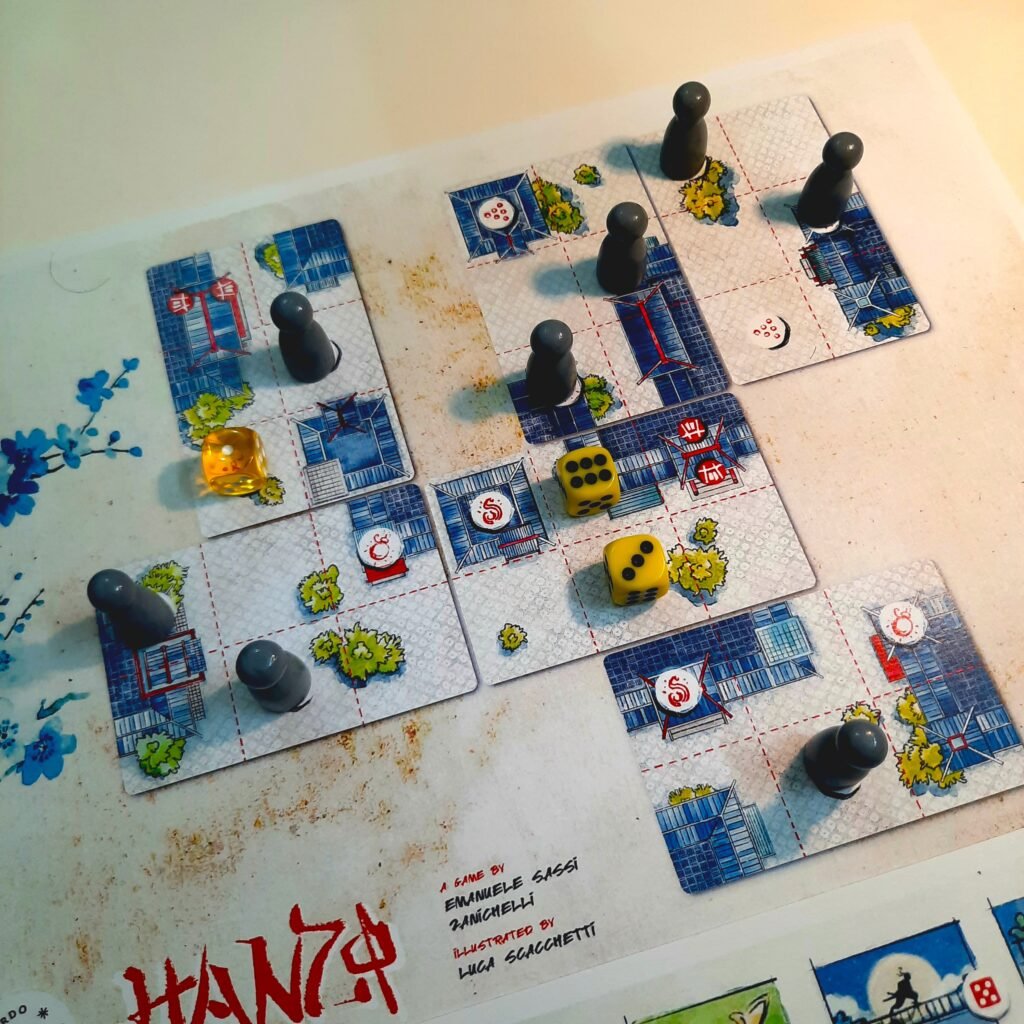
1v1 or Solo?
I’m a big fan of solo games, and Hanzō definitely qualifies as a game I’d love to play while listening to ninja tracks.
And then I played the game 1v1!
1v1 completely neutralized the one minor issue I had with Hanzō: making the moves of my enemies (Samurai) at the end of each round. There’s a little leeway for you to pick where to place the Samurai, from one of the two spots. It might be minor, but I can’t deny thinking of where best to place the Samurai so I could strategize the next round better. I had a similar experience with One Card Dungeon, a game I absolutely love, but one that also requires me to think on behalf of the enemy.
And I was delighted to see how it was balanced in 1v1 mode. It’s ninja vs Samurai, so each takes their own actions. The gameplay also varies a bit to make the contest even, and I really enjoyed it. There’s scope for strategy on both ends, and having multiple maps at my disposal made the game all the more replayable.
Time is slipping!
You need to be as quick as a ninja to back the game since the Kickstarter campaign is in its final stage.
So make your move, strike hard, and don’t let this legend slip through your fingers!
Recommended items
Game Overview
Publisher: Creardo
Designer: Emanuele Sassi Zanichelli
Artist: Luca Scacchetti
Number of players: 1 or 2
Difficulty level: Medium
Rounds of gameplay needed to learn: 1 round
Game duration: 20-30 minutes
Available on: Kickstarter
Theme: Unique dice mechanism | Ninja vs Samurai
Number of pages and color: 5 (color)
Assembling difficulty level: Super easy. No Assembly required
Lamination: Recommended if you are writing on the board and map with a whiteboard marker
Additional elements required: 12 meeples/playing pieces + 8 small tokens + 4 D6 dice.
Time to learn: Within 20 minutes
Travel-friendly: 9/10
Shelving friendly: 10/10
Rating from PnP Time: 8.5/10

Tasliman is a board game developer based in Bangladesh, with the dream of exploring the world of games and introducing it to anyone new to it. He is the founder of Kraftz, a brand that develops board games commercially, as well as with reputed entities like BRAC and The Gates Foundation.

